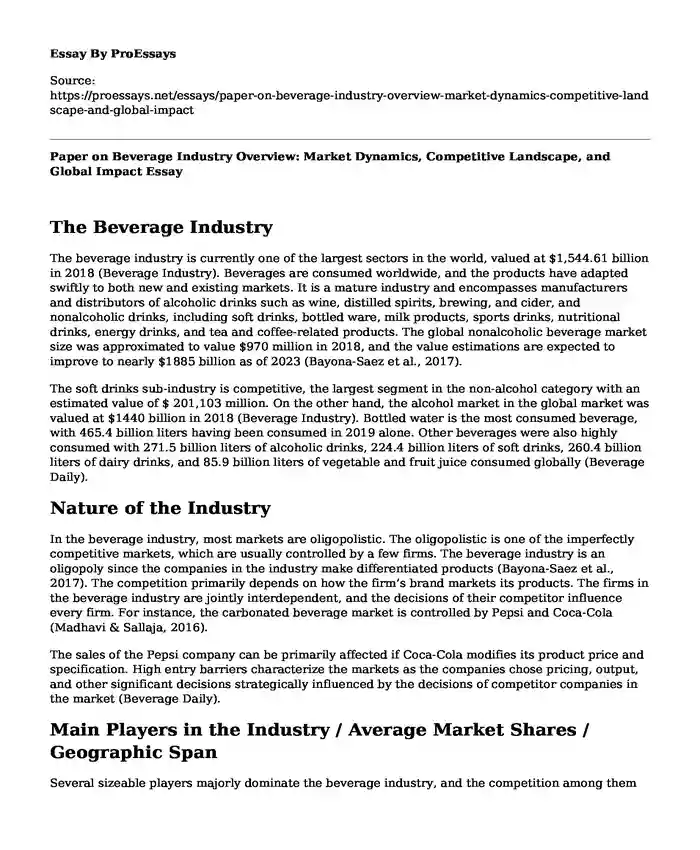The Beverage Industry
The beverage industry is currently one of the largest sectors in the world, valued at $1,544.61 billion in 2018 (Beverage Industry). Beverages are consumed worldwide, and the products have adapted swiftly to both new and existing markets. It is a mature industry and encompasses manufacturers and distributors of alcoholic drinks such as wine, distilled spirits, brewing, and cider, and nonalcoholic drinks, including soft drinks, bottled ware, milk products, sports drinks, nutritional drinks, energy drinks, and tea and coffee-related products. The global nonalcoholic beverage market size was approximated to value $970 million in 2018, and the value estimations are expected to improve to nearly $1885 billion as of 2023 (Bayona-Saez et al., 2017).
The soft drinks sub-industry is competitive, the largest segment in the non-alcohol category with an estimated value of $ 201,103 million. On the other hand, the alcohol market in the global market was valued at $1440 billion in 2018 (Beverage Industry). Bottled water is the most consumed beverage, with 465.4 billion liters having been consumed in 2019 alone. Other beverages were also highly consumed with 271.5 billion liters of alcoholic drinks, 224.4 billion liters of soft drinks, 260.4 billion liters of dairy drinks, and 85.9 billion liters of vegetable and fruit juice consumed globally (Beverage Daily).
Nature of the Industry
In the beverage industry, most markets are oligopolistic. The oligopolistic is one of the imperfectly competitive markets, which are usually controlled by a few firms. The beverage industry is an oligopoly since the companies in the industry make differentiated products (Bayona-Saez et al., 2017). The competition primarily depends on how the firm’s brand markets its products. The firms in the beverage industry are jointly interdependent, and the decisions of their competitor influence every firm. For instance, the carbonated beverage market is controlled by Pepsi and Coca-Cola (Madhavi & Sallaja, 2016).
The sales of the Pepsi company can be primarily affected if Coca-Cola modifies its product price and specification. High entry barriers characterize the markets as the companies chose pricing, output, and other significant decisions strategically influenced by the decisions of competitor companies in the market (Beverage Daily).
Main Players in the Industry / Average Market Shares / Geographic Span
Several sizeable players majorly dominate the beverage industry, and the competition among them is usually intense. In the nonalcoholic segment, two global entities control the market; Coca-Cola and Pepsi (Bayona-Saez et al., 2017). The companies distribute their popular carbonated and noncarbonated drinks across the world through sizeable bottling organizations. The bottling companies largely rely on these two sector leaders to develop new products, sustain adequate promotion, and enhance existing products (Madhavi & Sallaja, 2016). Due to globalization, the beverage industry has gained several advantages. Beverages have become more standardized across the world, which has led to the improved overall quality of the drinks sold globally. The worldwide distribution network enables the industry to be more efficient economically, generating opportunities relating to economies of scale both in production and marketing (Beverage Industry).
Additionally, the global market enables the industry to utilize cheap labor, by exploiting the comparative advantages held by different countries to create new products, acquire ingredients, locate manufacturing, and generate international marketing campaigns (Madhavi & Sallaja, 2016). While most beverages are consumed in their countries of manufacturing, globalization has led to growth in international trade, mostly across developed countries. To some extent, the increased globalization level and concentration has resulted in monopoly pricing and monopoly extraction of profits and has facilitated the development of larger economic and political actors in the context of each country.
References
Bayona-Saez, C., Cruz-Cázares, C., García-Marco, T., & García, M. S. (2017). Open innovation in the food and beverage industry. Management Decision. https://doi.org/10.1533/9780857097248
Beverage Daily. (n.d.). Big brands in the beverage industry. https://www.beveragedaily.com/Big-Brands
Beverage Industry. (n.d.). Beverage industry: category focus. https://www.bevindustry.com/topics/2237-category-focus#
Madhavi, B., & Sallaja, V. N. (2016). Comparative study on consumer perception towards carbonated beverage industry with respect to Coca Cola and Pepsico. International Journal of Current Reserch, 8(5), 32146-32151. http://www.journalcra.com/sites/default/files/issue-pdf/14955.pdf
Cite this page
Paper on Beverage Industry Overview: Market Dynamics, Competitive Landscape, and Global Impact. (2023, Dec 17). Retrieved from https://proessays.net/essays/paper-on-beverage-industry-overview-market-dynamics-competitive-landscape-and-global-impact
If you are the original author of this essay and no longer wish to have it published on the ProEssays website, please click below to request its removal:
- Thesis Example on the Relationship Between Migration and Unemployment among Migrants in Sweden
- Taxes and Unemployment Benefit Essay
- Apple Price Question Essay
- The Methodology of Underwater Concrete Pouring Essay
- Essay on Supply and Demand Challenges Continue for Beef Industry
- Essay Sample on Apple: The Innovative Company Shaping the World
- Essay Example on Ergonomics: Applied Science for Safe & Efficient Human Interaction







